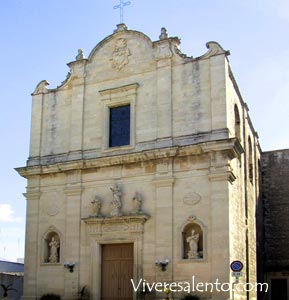|
|

At Giurdignano there are
a lot of historical and artistic monuments to see. For example you can visit
 the
ancient noble residences as the imposing Baronial Palace, built in the XVIII
century on a pre-existing XVI century fortress. On the external façade there are
some elegant decorations and a very beautiful balcony. Greco Palace is very
enchanting as well, and the typical case a corte too. The Mother Church
was devoted to St. Rocco and it was built in the XVII century where once there
used to be the ancient Church of St. Salvatore. The façade has a beautiful
front door, on which there are three sculptures situated in two niches
containing the statues of St. Vincent and St. Rocco, and a big window
well-adorned. In this church with nave and two aisles you can see some baroque
altars and very precious canvasses made by Gaspare De Giovanni and Saverio
Lillo, both artists of the Salento. Opposite the church there is the XVIII
century Column of St. Rocco, that the captain of a ship ( that had escaped from
the plague by miracle) made build. Another interesting ancient monument is the
Crypt of St. Salvatore (three aisles) where you can see three ancient altars and
wonderful frescos. In territory of Giurdignano there are two other crypts, that
of St Orsola and that of St. Vito. Outside the inhabited centre there are still
the rests of an ancient Basilian Abbey called "Centoporte" because of the
several windows. It was a church with nave and two aisles and the walls were all
full of paintings . The abbey was used in the XII century as a church. The
protector of Giurdignano is St. Rocco, that is celebrated solemnly on August
16th. the
ancient noble residences as the imposing Baronial Palace, built in the XVIII
century on a pre-existing XVI century fortress. On the external façade there are
some elegant decorations and a very beautiful balcony. Greco Palace is very
enchanting as well, and the typical case a corte too. The Mother Church
was devoted to St. Rocco and it was built in the XVII century where once there
used to be the ancient Church of St. Salvatore. The façade has a beautiful
front door, on which there are three sculptures situated in two niches
containing the statues of St. Vincent and St. Rocco, and a big window
well-adorned. In this church with nave and two aisles you can see some baroque
altars and very precious canvasses made by Gaspare De Giovanni and Saverio
Lillo, both artists of the Salento. Opposite the church there is the XVIII
century Column of St. Rocco, that the captain of a ship ( that had escaped from
the plague by miracle) made build. Another interesting ancient monument is the
Crypt of St. Salvatore (three aisles) where you can see three ancient altars and
wonderful frescos. In territory of Giurdignano there are two other crypts, that
of St Orsola and that of St. Vito. Outside the inhabited centre there are still
the rests of an ancient Basilian Abbey called "Centoporte" because of the
several windows. It was a church with nave and two aisles and the walls were all
full of paintings . The abbey was used in the XII century as a church. The
protector of Giurdignano is St. Rocco, that is celebrated solemnly on August
16th.

The
nickname of the inhabitants of Giurdignano is "tignusi" that means "affected
with ringworm" . That nickname was given to them because in the past the
population were affected with this terrible illness caused by a virus lying
under the hair and that causes the fall all the hair. The virus is
|